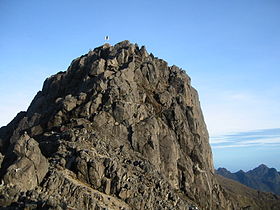Mount Wilhelm
| Mount Wilhelm | |
|---|---|
| Enduwa Kombugluor Kombugl'o Dimbin | |

The granite peak of Mount Wilhelm
|
|
| Highest point | |
| Elevation | 4,509 m (14,793 ft) |
| Prominence | 2,969 m (9,741 ft) Ranked 97th |
| Isolation | 539 kilometres (335 mi) |
| Listing |
Country high point Ultra |
| Coordinates | 05°48′S 145°02′E / 5.800°S 145.033°ECoordinates: 05°48′S 145°02′E / 5.800°S 145.033°E |
| Geography | |
| Location | Intersection of Simbu, Jiwaka and Madang provinces in Papua New Guinea |
| Parent range | Bismarck Range |
| Climbing | |
| First ascent | 15 August 1938 by Leigh Vial |
| Easiest route | Rock scramble |
Mount Wilhelm, or Enduwa Kombuglu, or Kombugl'o Dimbin at 4,509 metres (14,793 ft) is the highest mountain in Papua New Guinea. It is part of the Bismarck Range and the peak is the point where three provinces, Simbu, Jiwaka and Madang, meet. The peak is also known as Enduwa Kombugluor Kombugl'o Dimbin in the local Kuman language, a Papuan language.
The mountain is on the island of New Guinea, which incorporates Papua New Guinea and the Indonesian province of Papua. It is surpassed by Puncak Jaya, 4,884 m (16,024 ft), and several other peaks in Indonesian Papua.
Mount Wilhelm may be claimed as the highest mountain in Oceania (including Australia and New Zealand), on account of Indonesia being partially in Asia. A Seven Summits list sometimes includes Mount Wilhelm.
It was not until August 1938 when Leigh Vial, a government patrol officer, and two Papuan New Guineans, his "Mangi mastas", "Namba Wan Bare Kuakawa" and "Gend" from "Mondia Nigle", made the first recorded ascent. It was noted by Vial that even though the mountain was close to the equator, snow existed on top of the mountain at the time of ascent.
During the Second World War in the early hours of May 22, 1944, an American F-7A (a converted B-24 Liberator) named "Under Exposed" crashed into the mountain while flying too low. The aircraft left from Nadzab airbase, close to Lae, and had been assigned for a reconnaissance mission to photograph Padaidori Island in Dutch New Guinea. Around 0400 the plane crashed into Wilhelm at about 13,000 feet (4,000 m) above the twin lakes. All crew were killed and most of the wreckage landed in the topmost lake although some can still be seen today. The only remains at the site are from the plane, as all bodies have been recovered.
...
Wikipedia

